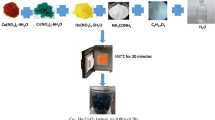Abstract
The effect of humidity on the phase, microstructure, and electrical properties of an organic compound orange dye (C17H17N5O2) and cuprous-oxide (Cu2O) micro-composite thin film has been investigated. 5 wt% commercially available orange dye and 30–40 wt% Cu2O were used to prepare an aqueous solution. The solution was layered in the form of a thin film on a pre-deposited copper glass substrate using a drop-casting technique under normal gravity conditions. A gap was made in the middle of the surface to get ohmic type electrodes at the ends of the glass substrate. In this way, a Cu/Cu2O–OD/Cu humidity sensor was fabricated. A self-made setup was used to carry out the experiment. Impedance of these samples was observed to decrease by 57–84 times and capacitance increased by 20–26 times with an increase in humidity from 62 to 98% RH. These observations demonstrated that impedance was more sensitive to the variations in humidity as compared to capacitance.







Similar content being viewed by others
References
Q. Weng, S. Yang, Urban air pollution patterns, land use, and thermal landscape: An examination of the linkage using GIS. Environ. Monit. Assess 117, 463–489 (2006)
Z.M. Rittersma, Recent achievements in miniaturised humidity sensors—a review of transduction techniques. Sensor. Actuat. A-Phys 96, 196–210 (2002)
J. Joyce, B. Adamson, T. Huntley, R. Parr, Baxter, Standardisation of temperature observed by automatic weather stations. Environ. Monit. Assess 68, 127–136 (2001)
Y. Anjaneyulu, I. Jayakumar, V.H. Bindu, P.V.M. Rao, G. Sagareswar, K.V. Ramani, Real-time remote monitoring of air pollutants and their online transmission to the web using internet protocol. Environ. Monit. Assess 124, 371–381 (2007)
C.Y. Lee, G.B. Lee, Humidity sensors: A review. Sens. Lett. 3, 1–15 (2005)
Z. Chen, C. Lu, Humidity sensors: A review of materials and mechanisms. Sens. Lett. 3, 274–295 (2005)
K.S. Karimov, M. Saleem, Z.M. Karieva, A. Mateen, M.T.S. Chani, Q. Zafar, Humidity sensing properties of Cu2O-PEPC nanocomposite films. J. Semicond 33, 073001 (2012)
J. Korvink, L. Chandran, Accurate 3D capacitance evaluation in integrated capacitive humidity sensors. Sensors Mater 4, 323–323 (1993)
S. Park, J. Kang, J. Park, S. Mun, One-bodied humidity and temperature sensor having advanced linearity at low and high relative humidity range. Sensor Actuat. B 76, 322–326 (2001)
K.C. Brion, Moisture sensors in process control. (Elsevier Applied Science Publishers, USA, 1986)
M. Matsuguchi, Y. Sadaoka, K. Nosaka, M. Ishibashi, Y. Sakai, T. Kuroiwa, A. Ito, Effect of sorbed water on the dielectric properties of Acetylene-Terminated Polyimide resins and their application to a humidity sensor. J. Elctrochem. Soc 140, 825–829 (1993)
K.S. Karimov, I. Qazi, T.A. Khan, P.H. Draper, F.A. Khalid, M.M. Tahir, Humidity and illumination organic semiconductor copper phthalocyanine sensor for environmental monitoring. Environ. Monit. Assess 141, 323–328 (2008)
A.O. Musa, T. Akomolafe, M.J. Carter, Production of cuprous oxide, a solar cell material, by thermal oxidation and a study of its physical and electrical properties. Sol. Energ. Mat. Sol. C 51, 305–316 (1998)
M.T.S. Nair, L. Guerrero, O.L. Arenas, P.K. Nair, Chemically deposited copper oxide thin films: structural, optical and electrical characteristics. Appl. Surf. Sci 150, 143–151 (1991)
H. Zhang, D.M. Goodner, M.J. Bedzyk, T.J. Marks, R.P.H. Chang, Formation and kinetics study of cuprous oxide nanodots on LaAlO3 (0 0 1). Chem. Phys. Lett. 395, 296–301 (2004)
N.M. Shanid, M.A. Khadar, Evolution of nanostructure, phase transition and band gap tailoring in oxidized Cu thin films.. Thin Solid Films 516, 6245–6252 (2008)
D.U. Kim, M.S. Gong, Thick films of copper-titanate resistive humidity sensor. Sensor Actuat. B 110, 321–326 (2005)
P. Slezak, A. Wieckowski, Aqueous electrochemical synthesis of YBa2Cu3O7 – x superconductors. J. Electrochem. Soc 138, 1038–1040 (1991)
K.S. Karimov, M. Abid, M. Saleem, M. Farooq, Z.M. Karieva, A. Khan, Cu2O–PEPC composite based pressure transducer. Arab J. Sci. Eng 37, 1491–1498 (2012)
S.B. Abolmaali, J.B. Talbot, Synthesis of superconductive thin films of YBa2Cu3O7–x by a Nonaqueous Electrodeposition Process. J. Electrochem. Soc 140, 443–445 (1993)
T. Mahalingam, C. Sanjeeviraja, Galvanostatic deposition of Cu2O layers through the electrogeneration of base route. J. Mater. Sci. Lett 17, 603–605 (1998)
F.N. Meng, X.P. Di, H.W. Dong, Y. Zhang, C.L. Zhu, C. Li, Y.J. Chen, Ppb H2S gas sensing characteristics of Cu2O/CuO sub-microspheres at low-temperature. Sensor Actuat. B 182, 197–204 (2013)
S.A. Moiz, K.S. Karimov, N.D. Gohar, Orange dye thin film resistive hygrometers. Eurasian Chem. Tech. J 6, 179–183 (2004)
K.S. Karimov, M. Abid, M.M. Tahir, M. Saleem, A. Khan, Z.M. Karieva, M. Farooq, V2O4–PEPC composite based pressure sensor. Microelectron. Eng 88, 1037–1041 (2011)
R.L. Boylestad, Introductory circuit analysis, 12th edn., Pearson Education India (2000)
J.D. Irwin, Basic engineering circuit analysis, 6th edn. (Wiley, New York, 1999)
M.A. Omar, Elementary Solid State Physics: Principles and Applications. (Pearson Education Pte Ltd, Singapore, 2002)
S.N. Boguslavsky, V.V. Vannikov, Organic Semiconductors, V.A. Kargin, (Nauka, Moscow, 1968)
C.L. Hsu, J.Y. Tsai, T.J. Hsueh, Ethanol gas and humidity sensors of CuO/Cu2O composite nanowires based on a Cu through-silicon via approach. Sensors Actuat. B 224, 95–102 (2016)
Acknowledgements
The authors are thankful to the authority of GIK Institute for the support of research in the area of organic semiconductor and devices fabrication and investigations. The authors also acknowledge the financial support (ADP No. 130314) extended by the KPK Govt. through DoST, KPK for the Materials Research Laboratory, University of Peshawar.
Author information
Authors and Affiliations
Corresponding author
Ethics declarations
Conflict of interest
The authors declare no competing financial interest.
Rights and permissions
About this article
Cite this article
Karimov, K.S., Saleem, M., Iqbal, Y. et al. Phase, microstructural analysis, and humidity-sensing properties of orange dye and cuprous-oxide composite. Appl. Phys. A 123, 740 (2017). https://doi.org/10.1007/s00339-017-1343-1
Received:
Accepted:
Published:
DOI: https://doi.org/10.1007/s00339-017-1343-1




